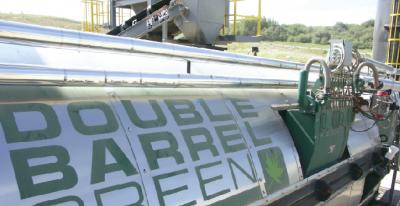
Features
Roads & Paving
Technology
Lafarge walks the green talk
Putting corporate philosophy into practice
January 2, 2009 By Andy Bateman
A new asphalt operation puts corporate philosophy into practice.
 |
|
| Astec’s Double Barrel Green system uses water to produce a foamed warm mix asphalt. Described as a major breakthrough in warm mix asphalt technology, the system does not require additives.
|
The setting of corporate goals can be a lot easier than implementing them, particularly in uncertain times. Not so at Lafarge which, in addition to its leadership in the reduction of emissions from cement production, “seeks to reduce the environmental impact of construction and promote sustainable construction methods.” Recent investment at one of the company’s operations demonstrates corporate philosophy in action, with a new asphalt plant combining energy efficiency, warm mix asphalt capability and increased throughput capacity.

|
|
| A Komatsu WE480 wheel loader maintained material feed supply to the new plant. Advertisement
|
Mike Tiffen, General Manager, Asphalt, explains that there were a number of factors driving the replacement of the old 12 000 lb batch plant at the company’s Spy Hill operation in Calgary. “The batch plant was often operating near its capacity limit of 250 tonnes/h and was also not well suited to the large volume continuous production increasingly demanded by today’s marketplace. Having a plant with the versatility to produce advanced mixes such as Superpave and Stone Mastic Asphalt has also become more important, as was the ability to produce warm asphalt mixtures without plant modifications. With the old plant, producing warm mix was something of a “circus” and required a number of temporary plant modifications to add the mix constituents. Warm mixtures are currently only a small percentage of total production, but we expect that percentage to significantly increase as warm mix gains general market acceptance. With the investment of some $6 million in the new plant, we now have the capability to meet all of these market changes while realising the lower unit operating costs of a more efficient production process.”
 |
|
| Mike Arsenault, plant operator at the Spy Hill plant.
|
In operation, cold feed selected from eight feed bins is conveyed via belt feeders and a common 762 mm collecting conveyor to a 4 by 12 scalping screen. From there, feed is conveyed to the plant on a 762 mm by 18.3 m inclined conveyor incorporating an
Accu-Swipe automatic aggregate sampler and a second air bag tensioned belt scraper. Cold feed is dried and heated in the inner drum of the Double Barrel Drum Mixer and then mixed with design quantities of asphalt cement, RAP, returned dust and any additives in the mixer’s stationary outer drum. Product discharging from the drum is elevated to the top of three 180 tonnes capacity product silos by a 914 mm single chain drag conveyor and directed to the appropriate silo by two 914 mm traverse conveyors. The production process is controlled from a new command control centre, where the TC 2000 HMA Programmable Logic Control (PLC) control system includes a WM 2000 Weight Mate computer for silo load out.
| Why warm mix ? For both roadbuilders and asphalt producers, the list of benefits claimed for Warm Mix Asphalt (WMA) is a long one. For roadbuilders, these benefits include reduced emissions during paving and comparable quality, usually with existing equipment. For asphalt producers, warm mix means reduced emissions during the production process, lower aggregate drying costs, lower oil heating costs and, at the plant described here, the avoided cost of the chemical additives generally used in WMA production. Also of interest to producers is WMA’s potential to increase the service area of an asphalt plant, thanks to longer haul times as mix heat loss during delivery is a function of the difference between mix and ambient temperatures. Cooler production temperatures mean less delivery heat loss, allowing haul times and delivery distance to be increased. Recent work suggests that warm mix may also extend pavement service life by several years compared to the equivalent hot mix asphalt pavement. Warm asphalt mixtures have been found to age harden significantly less during the production process and, as a result, the warm mixture goes into service with a higher percentage of its total life remaining. |
The new plant incorporates a number of design features to increase plant versatility and capability. For example, the whole plant is relocatable, with major components such as the drum and bag house skid mounted to facilitate relocation if required. Like its sister operation at Port Kells B.C., the plant’s eight cold feed bins facilitate the production of additional mixtures utilising aggregates from different sources. The same philosophy applies to the installation of four recycle bins compared to the one or two typically seen. By fractionating the RAP into different sizes, both the size and quantity of recycled asphalt cement and recycled aggregates going into the mixture can be more closely controlled. In this regard, the Spy Hill plant is well served by internal supply and support processes. Not only is the processing of both aggregates and fractionated RAP completed at the same Spy Hill location, but significant technical support is also provided by the company’s nearby regional laboratory for western Canada as well as a quality control laboratory.
For the technically inclined, the plant’s specifications include a number of additional design details to increase up time, production flexibility and energy efficiency. At the feed end, each of the four recycle bins is equipped with an air cannon to dislodge any bridged material while the belting on the RAP system has vulcanized rather than spliced joints to maximise joint durability. Still on raw materials, each of the four CEI Enterprises 113,500 litre vertical asphalt tanks has 150 mm of insulation, while the 2 000 000 Btu helical coil oil heater has a combination gas/oil burner and a Stackpack stack heat exchanger. The 8 by 40 Double Barrel drum mixer itself is fitted with a Phoenix 100MBtu/hr combination gas/ No. 2 oil burner, allowing the plant to be fired by either fuel if required. At the 68 194 cfm pulse jet baghouse, the 250hp motor driving the exhaust fan has variable frequency drive to reduce electricity consumption, while the 2.7 tonnes capacity enclosed bin loading batchers over at the product storage are equipped with access doors to facilitate maintenance.
As described by its manufacturers, Astec’s Double Barrel Green system uses water to produce a foamed warm mix asphalt that is odourless, smokeless and longer lasting. The Double Barrel Green system is a major breakthrough in warm mix asphalt
technology because it does not require the addition of expensive commercial additives. Instead, water is injected into the mix along with the liquid asphalt cement. The injection of water causes the liquid asphalt to foam and expand in volume. The foaming action helps the liquid asphalt coat the aggregate at a lower temperature. Reported benefits of the system include no smoke and no smell because the light oils in liquid asphalt never reach the boiling point. The Double Barrel Green system has the ability to run high percentages of recycle mix with a standard grade of asphalt. Due to 28 Celsius lower temperatures, approximately 14 per cent less fuel is used corresponding to a 14 per cent increase in production. The Double Barrel Green system is optional on any new Astec Double Barrel drum mixer/dryer or can be added as a retrofit.
The benefits of warm mix asphalt such as reduced energy consumption, lowered emissions and elimination of visible smoke are now well known in the hot mix industry. Warm mix technology allows mix to be prepared and placed at temperatures that are typically 30 to 60 degrees Celsius lower than conventional hot mix. However, the asphalt cement must remain free flowing (have low viscosity) at these lower temperatures to allow the mixture to flow freely through storage, transfer and placement equipment and also allows its working by hand on site.
According to Astec, all previous warm mix asphalt technologies rely on the use of additives, special asphalt cement, special procedures and /or special asphalt cement (AC) delivery systems to achieve low viscosity at low temperatures. Such additives and systems are said to significantly increase the asphalt production cost.
By contrast, the Astec Multi Nozzle Device eliminates the need for additives and special asphalt cement to maintain free flowing asphalt cement at low temperatures. The device consists of multiple valves, mixing chambers and nozzles supplied by a common AC manifold. In operation, it mixes a small amount of water and AC together to create microscopic bubbles in the well known foaming reaction. These small bubbles act to reduce the viscosity of the AC coating on the aggregate, thereby allowing the mix to be handled and worked at a lower temperature than a conventional hot mix.
With each nozzle capable of passing AC and producing foam for 45 tonnes/h of production, the ten production valve assemblies in the multi nozzle arrangement provide capacity for production rates of 450 tonnes-h when all valves are opened. As production rates vary, a computer control opens and closes these AC solenoid valves sop that each valve assembly and nozzle operates in a narrow range of AC flow and back pressure to achieve consistent foam in the foaming chamber. An eleventh valve is located on the AC manifold for taking AC samples.
Water is delivered to the system via a positive displacement piston pump capable of delivering water at pressures in excess of 1034 kPa (150psi). Water pump speed is modulated proportionally to the speed of the liquid AC pump to accurately meter water into AC valve-nozzle assemblies. Individually controlled water solenoid valves control the flow of water into each nozzle for each nozzle assembly so that the water solenoid valves open at the same time each of the AC solenoid valves open. Programmable Logic Control (PLC) adjusts all the valves as production rates increase or decrease. Water is supplied to the system via a skid mounted two100 litre water reservoir with an automatic filling valve and low water alarm. n
Print this page